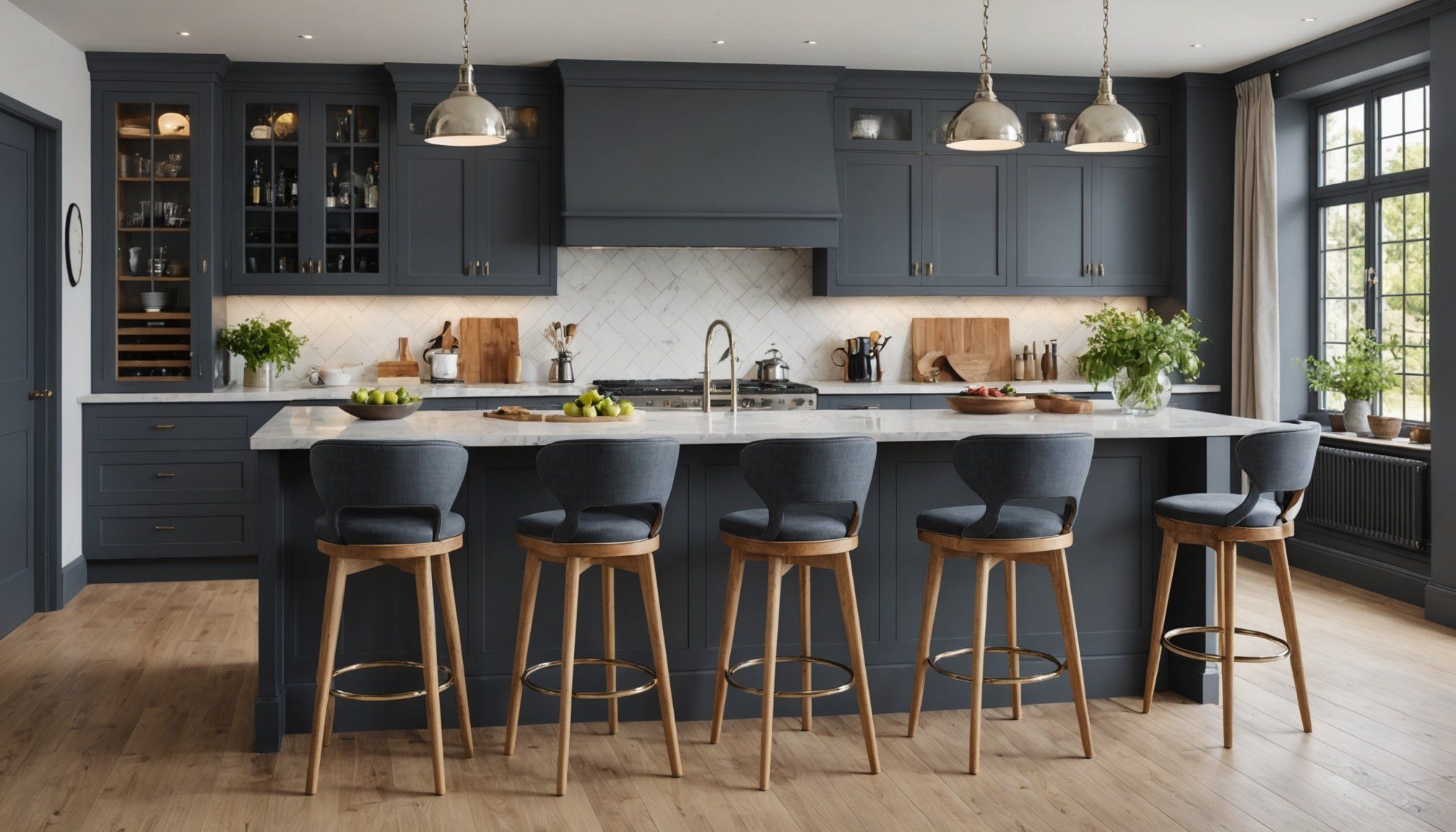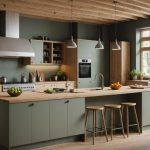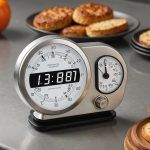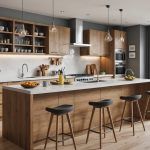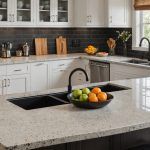Introduction to Bar Stools for Kitchen Islands
In recent years, kitchen islands have become a central feature in many UK homes, serving both functional and aesthetic purposes. To complement these islands, choosing the ideal bar stools is crucial. Bar stools not only offer practical seating solutions but also enhance the overall design of the kitchen. They can reflect personal style and tie together different design elements present in your kitchen space.
When selecting bar stools for kitchen islands, several factors should be considered. Comfort and height are paramount; stools should allow for easy conversation and accessibility to the island. A general rule is to leave approximately 25-30 cm of space between the seat of the stool and the underside of the island to accommodate legroom comfortably. Additionally, since kitchen islands often serve multiple functions from meal prep to socialising, the materials and durability of the stools play a significant role in ensuring longevity in high-usage areas.
In the same genre : Revamp Your UK Kitchen with a Chic and Functional Breakfast Bar: Comprehensive DIY Guide
With the wide array of bar stool styles available, from contemporary to traditional, it’s essential to match the aesthetics of the stools with your kitchen’s overall decor. Adopting design trends from the UK can further refine this decision, ensuring harmony and coherence.
Understanding Sizes and Heights
Ensuring the right bar stool sizes and height standards is crucial when choosing stools for your kitchen island. A standard bar stool height range is between 26 to 30 inches, designed to fit comfortably under kitchen islands that are typically 34 to 36 inches high.
Also to read : Choosing the Ideal Refrigerator Size for Expanding Families in the UK: An In-Depth Guide
To measure your kitchen island dimensions accurately, first determine the counter height. Subtract 10-12 inches from the counter height to find the perfect bar stool height, allowing ample space for seating comfort. This gap ensures legroom, supporting ergonomic posture and making it easier to rise from the stool.
Another consideration is the island’s width and the number of stools it can accommodate. Generally, allow 28-30 inches between the centers of each stool for adequate space.
Prioritising ergonomics and comfort is crucial in selecting the right size. Look for stools with footrests and consider swivel mechanisms or padded seating for added comfort, especially if the space is used for prolonged periods, such as dining or entertaining. The combination of ergonomically-designed seating with the dimensions of your kitchen ensures that the stools meet functional and aesthetic needs, enhancing your kitchen’s appeal.
Style and Design Considerations
Selecting the perfect bar stool styles involves considering the different aesthetics available, from contemporary to traditional and even industrial designs. Each style offers a unique appeal and can complement the design elements of your kitchen space. Contemporary styles often feature sleek, minimalistic lines, ideal for modern kitchens with a focus on simplicity. In contrast, traditional styles may incorporate ornate details and classic shapes, enhancing more classic kitchen aesthetics. Industrial bar stools, often made from metal or recycled materials, add a rugged charm suitable for more eclectic or rustic interiors.
When choosing bar stools, it’s vital to match their designs with your kitchen’s overall decor to ensure cohesion. Consider colour schemes, the presence of metallic accents, or the warmth of wood within your kitchen, and select bar stools that complement these features. Additionally, UK design trends often influence the popularity of certain styles, so keeping abreast of these can help refine your choices. This approach ensures the stools do not only serve as functional pieces but also as integral parts of your kitchen’s design story, enhancing both usability and aesthetic value.
Material Choices and Durability
Selecting the right bar stool materials is a significant consideration for any kitchen island setup, balancing aesthetics and functionality. Common materials used in bar stools include wood, metal, and upholstery, each offering distinct benefits. Wood provides a warm, classic, and versatile look, fitting seamlessly into various kitchen designs. It’s particularly popular for those aiming for a rustic or traditional ambiance. Metal, such as stainless steel or aluminium, presents a sleek and modern finish, ideal for contemporary kitchens, and is prized for its durability and easy maintenance. Upholstery, offering options in leather or fabric, adds a luxe touch, providing comfort and an opportunity to play with patterns and colours.
Durability is crucial, especially in high-usage areas like the kitchen. Metal frames and solid wood are typically robust choices but consider how materials fare against spills or scratches. Choose finishes that resist wear and tear over time, ensuring your investment withstands daily use. For styles that marry elegance and sturdiness, consider combining materials, such as a wooden seat with metal legs, maintaining both style and practicality. This careful selection of materials ensures the ideal bar stools meet both aesthetic desires and practical needs.
Color Preferences and Customization
Choosing the right bar stool colors can significantly impact the ambience of your kitchen, especially with kitchen islands being prominent features. There has been a rising interest in experimenting with vibrant colours like teal and mustard in the UK, adding character and flair to kitchen designs. Yet, classic neutrals such as grey, black, or white remain timeless, offering versatility and a sleek look.
When selecting bar stool colors, ensure they complement your kitchen’s existing color palettes. If your kitchen decor primarily includes muted tones, introducing a pop of colour through bar stools can create an eye-catching focal point. Conversely, in vibrantly themed kitchens, opting for bar stools in muted shades can maintain harmony without overwhelming the space.
Customization options are aplenty. Many retailers offer bespoke services allowing homeowners to select fabrics, finishes, and hues that reflect their personal style. This customization not only aligns with aesthetic preferences but can also enhance the durability and functionality of the stools. By investing in custom options, you’re ensuring the bar stools resonate with your vision—providing both comfort and style iterations suitable for any UK kitchen.
Retailers and Where to Buy
Finding reputable retailers in the UK to purchase bar stools can seem daunting given the plethora of options. Key players in the market include:
- John Lewis: Known for their quality and design, they offer an extensive range of bar stools suitable for various styles.
- Wayfair: Offers competitive pricing and a vast selection, catering to both traditional and contemporary tastes.
- IKEA: A go-to for budget-friendly yet stylish stools, ideal for modern kitchen setups.
Online shopping provides unparalleled convenience, but comes with its considerations. It allows for easy price comparison and access to diverse styles, though the experience may lack the tactile reassurance of in-store assessments. Retailers like Wayfair and John Lewis offer detailed descriptions and customer reviews online, aiding informed decisions.
When shopping online, consider shipping and return policies. Some retailers provide free delivery and easy return options, which can be crucial if the stools do not meet expectations upon arrival. Buying in-store offers a chance for physical inspection, ensuring comfort and quality before purchase. Balancing these factors can lead to a satisfying acquisition of the ideal bar stool to suit your kitchen’s needs.
Expert Opinions and Customer Reviews
Understanding the significance of bar stool reviews is integral to making informed purchasing decisions. While selecting bar stools for kitchen islands, reviews from both experts and customers provide valuable insights.
Customer feedback often highlights common pitfalls, such as stability issues or discrepancies between advertised and actual colours. For instance, some users mention that the perceived durability of wood and metal stools can vary, depending on the finish and craftsmanship. Experts suggest ensuring appropriate assembly to avoid these issues, emphasizing the importance of precise installation for optimal stability.
An expert recommendation often involves evaluating models that consistently meet standards for comfort and aesthetics. Popular bar stool models typically feature durable materials and ergonomic designs that enhance comfort without compromising on style. Recommendations also include checking the warranty and support services offered by manufacturers, ensuring prolonged satisfaction with the product.
Before purchasing, browse reviews to compare models and identify any recurring concerns. By understanding the experience of others with similar kitchen designs, you’re better positioned to select stools that are both functional and stylish, aligning with your kitchen’s aesthetic and practical requirements.
FAQs on Bar Stools for Kitchen Islands
When choosing bar stools for kitchen islands, several questions often arise. The most common concern is bar stool height. What height should bar stools be for a kitchen island? Ideally, stools should measure 26 to 30 inches to suit 34 to 36-inch islands. This ensures comfortable seating and enough legroom.
Next, maintaining bar stools. How do you keep bar stools clean? Regularly wipe with a damp cloth and use specific cleaners for wood or upholstery. Metal bar stools benefit from avoiding abrasive cleansers to preserve their finish.
Regarding family-friendly and pet-friendly options, what should you consider? Choose materials that are easy to clean and resist scratches. Upholstered stools with removable covers are particularly useful for households with children or pets, allowing easy upkeep.
Moreover, are swivel stools practical for families? Yes, swivel mechanisms offer flexibility and ease of use, especially for children, enhancing accessibility and seating comfort.
Lastly, how can customization affect stool choice? Personalised options allow alignment with kitchen color palettes and design styles, ensuring your bar stools are as stylish as they are functional, meeting both aesthetic and practical needs.

